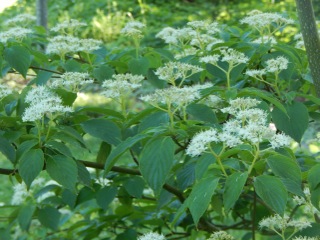Alternate-leaved dogwood (Swida alternifolia)
A deciduous shrub or small tree of the understory, alternate-leaved dogwood is often as wide as it is tall. This dogwood is a striking specimen in the landscape, with its strongly tiered, horizontal branching, providing unusual visual interest in all seasons. Beautiful dark blue fruits are savored by many bird species. Its range is from the Cape Breton highlands in Nova Scotia to Minnesota, south to northern Florida. Alternate-leaved dogwood thrives in a landscape or garden in partial shade, in soil with plenty of leafy mulch. All are relatively easy to propagate.
 June and early July are the coda for most of Maine’s flowering native trees and shrubs. American sheep-laurel (Kalmia angustifolia) lingers in the blueberry barrens, its rosy sconces ceding to the rising tide of blue fruit by the end of July. The wild roses (Rosa carolina, R. palustris, and R. virginiana) will bloom intermittently for the remainder of summer, stippling roadsides with their cheery flowers in every shade of pink. Northern bush-honeysuckle (Diervilla lonicera) is inexhaustible, producing small, pale yellow flowers into autumn. And the Sputnik orbs of buttonbush (Cephalanthus occidentalis) bloom in wetlands in August. But it is the late-flowering viburnums and dogwoods who usher out the last extravagance of bloom in our woods.
June and early July are the coda for most of Maine’s flowering native trees and shrubs. American sheep-laurel (Kalmia angustifolia) lingers in the blueberry barrens, its rosy sconces ceding to the rising tide of blue fruit by the end of July. The wild roses (Rosa carolina, R. palustris, and R. virginiana) will bloom intermittently for the remainder of summer, stippling roadsides with their cheery flowers in every shade of pink. Northern bush-honeysuckle (Diervilla lonicera) is inexhaustible, producing small, pale yellow flowers into autumn. And the Sputnik orbs of buttonbush (Cephalanthus occidentalis) bloom in wetlands in August. But it is the late-flowering viburnums and dogwoods who usher out the last extravagance of bloom in our woods.
Alternate-leaved dogwoods flower as withe-rod, Viburnum nudum, begins to fade. These two share a preference for cool, moist soils along with our two deciduous hollies, Ilex verticillata and I. mucronata. Ilex verticillata, winterberry, blooms just after alternate-leaved dogwood, but doesn’t really capture attention until its bright red fruit appears; its small, greenish-white flowers are sometimes overlooked beside the displays offered by the dogwoods and viburnums.
The flowers of alternate-leaved dogwood are showy, flat-topped cymes of creamy white, held proudly above the shrub’s glossy green, and deeply veined leaves. The leaves themselves crowd in whorls about the branch tips which turn upwards at the ends of their branches. Alternate-leaved dogwood’s smooth bark and branching structure are simply elegant. The horizontality of the limbs strengthens with maturity, especially single-trunked specimens. The emphatic layers or tiers of branches have given Swida alternifolia its most familiar common name, pagoda dogwood.
When alternate-leaved dogwood grows in partial, not deep shade, its flowers are abundant and their sweet scent attracts many insects, a raft of pollinators: Hymenoptera (bees, wasps, and flies), Lepidoptera (butterflies and moths), and Coleoptera (beetles). Mining bees (Andrenidae) are frequent dogwood visitors and long-horned beetles of the Cerambycidae Family are drawn to the flowers’ scent. Five species of aphid (Aphididae), thrips (Thripidae), sawflies (Tenthredinidae), and spittlebugs (Chrysomelidae) all dine unobtrusively on dogwood leaves, as do the larvae of Geometer moths (Geometridae) and owlet moths (Noctuidae). None of these associates chews itself out of a home.
Donald Stokes writes that “dogwoods are rated fifth among all woody plants in North America for their food value to wildlife.”[1] Doug Tallamy begins The Living Landscape with the image of a blue grosbeak’s nest of shed snakeskins, in an alternate-leaved dogwood planted close to his house. Later in the book he writes that alternate-leaved dogwood “is a great reminder that our plants are our bird-feeders”.[2]
Beautiful fruit follows the pollinated flowers. Green at first, then pink and finally bluish black when ripe, the fruits are held aloft by blood-red stems. Sometimes the different ripenesses of fruit are present altogether, a dramatic flourish of color against the abiding green foliage. The deeply-colored fruit stems are part of alternate-leaved dogwood’s autumnal display when the leaves turn burgundy.
The list of mammals and birds who consume the dogwood’s sugary fruit is lengthy. In fact, when the fruit ripens in August its usually abundant crop is quickly gone, devoured by at least eleven species of birds, including American robins, catbirds, waxwings, pewees, phoebes, red-eyed vireos, yellow-throated warblers, orchard orioles, brown thrashers and kingbirds. Imagining all these avian colors mingled with red-stalked indigo fruit is a visual surfeit.
Until the end of the nineteenth century, observers would have seen another bird perching and poised to dine on alternate-leaved dogwood: Passenger pigeons (Ectopistes migratorius) relished the dogwood’s fruit, hence another common, and very poignant name, pigeonberry.
The eradication of the passenger pigeon in North America is a tale most people know if only for its synonymy with extinction. 2014 was the one-hundredth anniversary of the death of “Martha”, the sole surviving captive passenger pigeon from a race of birds whose legendary flocks “blackened the sky in fact and not merely metaphor”.[3]
Passenger pigeons were hunted liberally and unheedingly throughout the eighteenth and early nineteenth centuries. The expanding railroads delivered hunters to known sites of roosting groups, and returned with trainloads of carcasses. Wild pigeons were a popular, seemingly everlasting and inexpensive food source. The social instincts of passenger pigeons were their downfall: solitary birds attracted flocks. The first legislative attempts to limit hunting (slaughter) were ridiculed because someone was always reporting a large flock seen somewhere. And suddenly it was too late. Passenger pigeons could only survive and reproduce in sizeable groupings where there was safety in numbers. The ultimate report of a passenger pigeon in Maine was in Dexter on August 16, 1896, eighteen years before Martha died in the Cincinnati Zoo.
The dogwood family is well-represented in North America and in Asia. Its most familiar members is flowering dogwood, Benthamidia florida (formerly Cornus florida), found sparingly in southern Maine, but commonly associated with the mid-Atlantic states and the Appalachians. This small tree with its iconic flower bracts is endangered by an anthracnose fungus (Discula destructiva) in the northern reaches of its range. Alternate-leaved dogwood does not seem to be affected by the disease although some trees suffer from golden canker, Cryptodiaporthe corni. This fungus is opportunistic, affecting branches already weakened by environmental stresses. The pace and extent of disease is visible when the tree is leafless and smaller branches are golden yellow, not rich reddish brown. Affected branches can be pruned away in winter while the dogwood is dormant. Healthy trees and shrubs are less susceptible; a cool, moist root zone and protection from too much sunlight reduce stress.
Propagating alternate-leaved dogwood requires gathering fruit before the birds have descended and stripped the tree bare- a surprisingly quick operation usually occurring in August. Squeeze the single seed from the fleshy fruit and sow immediately. Sown out of doors, germination will occur the following spring. Seeds need initial warmth, then cold stratification. To purchase alternate-leaved dogwood seeds, visit our online shop.
By Pamela Johnson
[1] Stokes, Donald. The Natural History of Wild Shrubs and Vines. Chester, Conn: East Woods Books, 1989. p. 170.
[2] Tallamy, Doug and Rick Darke. The Living Landscape. Portland, Oregon: Timber Press, 2014.
[3] Weidensaul, Scott. Return to Wild America. New York: North Point PRess, 2005. p. 27
[4] Kaufman, Ken. Lives of North American Birds. Boston: Houghton Mifflin Company, 1996.

